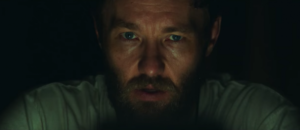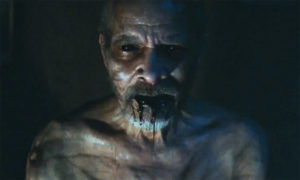 There is no way to spoil this film, because the film never reveals the “it” of its title. “It” is shrouded in as much resistant mystery by the end of the film as it is in the first scene. Its presence is felt in the roiling dread that drives Trey Edward Shults’ second full-length feature film. What comes at night is nebulous, just like the thing “it” seems to be an analogical stand-in for: fear.
There is no way to spoil this film, because the film never reveals the “it” of its title. “It” is shrouded in as much resistant mystery by the end of the film as it is in the first scene. Its presence is felt in the roiling dread that drives Trey Edward Shults’ second full-length feature film. What comes at night is nebulous, just like the thing “it” seems to be an analogical stand-in for: fear.
Shults spoke of the emotional reservoir he was retrieving from in the writing and making of this film during an interview with The Verge:
“I’ve been reading books on genocide, and thinking about people and our time on this world. Thinking about families, and how they’re like their own tribes, and how people put their tribe first. I think there’s a lot in how we live, where family always comes first. And if we think that way in any circumstance, we’re just going to end up destroying ourselves. It’s inevitable.”
Fear, according to Shults, is something that is created in the depths of our very emotional core. The content of fear, much like the threat that carries through the film, is ambiguous, but the expression of fear always finds a subject, usually something or someone “out there.” This idea of handling our fear through some form of isolation and tribalism—Shults speaks about above—breeds paranoia and decisions made in desperation, not out of rationality or compassion. While the tribe mentality may keep the monsters at bay for a while, the fear will never stop creeping its way in and the paranoia will turn inward on those in the tribe. Paul (Joel Edgerton), Sarah (Carmen Ejogo) and Travis (Kevin Harrison, Jr.) ultimately succumb to the very fear that kept them alive for so long and it costs the family and their immediate community severely.
 It would not be surprising if the reactions to this film are divided. It’s only barely a horror film, but it still is. It Comes At Night is the natural successor to the horror of the last couple of years like Get Out, The Babadook, and The Witch where stories of personal, deeply emotional turmoil are expressed in the nightmarish structural language of horror. People going into the film expecting a literal monster to be revealed from within the darkened wood will be disappointed, however those who are more sensitive and in tune with the story being told will find that the monster of the film is actually worse than anything cinema has showed us to date. We are shown to be the creature sauntering out of the wood with a gun in hand and the look of Cain in our eyes.
It would not be surprising if the reactions to this film are divided. It’s only barely a horror film, but it still is. It Comes At Night is the natural successor to the horror of the last couple of years like Get Out, The Babadook, and The Witch where stories of personal, deeply emotional turmoil are expressed in the nightmarish structural language of horror. People going into the film expecting a literal monster to be revealed from within the darkened wood will be disappointed, however those who are more sensitive and in tune with the story being told will find that the monster of the film is actually worse than anything cinema has showed us to date. We are shown to be the creature sauntering out of the wood with a gun in hand and the look of Cain in our eyes.
It Comes At Night excels at presenting a claustrophobic diagnosis of humanity’s fatal wound, one that has always been with us and will never heal, at least in this world. It also seems to be a fitting—though on-the-nose—assessment of the American present in the wake of racial disharmony, the refugee crisis, ISIS, Russian collusion, among many other perils of our day. America is, in effect, the family showcased in the film. We’ve been living according to our tribe for so long that we are finally reaping the consequences of that mindset and violence, paranoia and disunity seem to be rearing their head with a rather public show of force.
The tragedy for the family at the heart of this film’s narrative—and for America, metaphorically—is that fear will always get beyond the red door, it will always infiltrate the tribe, and those in the tribe, those in the family, those fellow countrymen will eventually become the “other” and that is when bloodshed tends to happen.
 As if that isn’t terrifying enough, the real gut punch of the film is similar in theme to last year’s 10 Cloverfield Lane in that it is possible for a person to be both paranoid and harmful to those with which they come in contact while still being, at least, somewhat justified in their paranoia and fear. There are threats out there in the world, in our own communities, and in our very own families, but the lesson to be gained from It Comes At Night is not to live according to one’s fears however justifiable they might be, but that fear cannot be overcome by isolation and tribalism, but, instead, giving our fears over to love even if it leads us to our own death instead of another’s by our own hands.
As if that isn’t terrifying enough, the real gut punch of the film is similar in theme to last year’s 10 Cloverfield Lane in that it is possible for a person to be both paranoid and harmful to those with which they come in contact while still being, at least, somewhat justified in their paranoia and fear. There are threats out there in the world, in our own communities, and in our very own families, but the lesson to be gained from It Comes At Night is not to live according to one’s fears however justifiable they might be, but that fear cannot be overcome by isolation and tribalism, but, instead, giving our fears over to love even if it leads us to our own death instead of another’s by our own hands.
When the credits roll, Shults leaves the audience freewheeling in the relentless mystery of what is going on around the families in the film. What is known is the choices made out of fear by people affect others, let alone their own tribe/family, in sometimes horrible ways. This is the world we know. The world we hope for is found by courageously reaching our hands out to whatever “it” lies in the woods beyond our walls.


